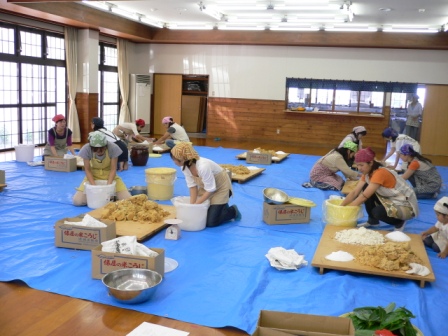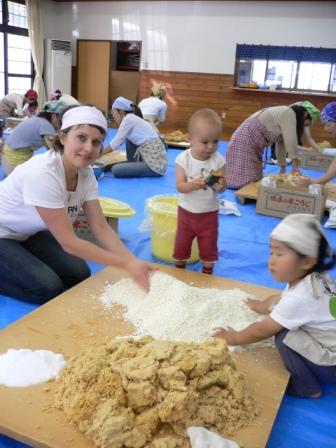2008年07月01日
Miso- making and some details
Today I took part in the process of making miso paste. It was an enjoyable experience. My friend Yoko organized and prepared the ingredients and I joined their group. The Japanese ladies brought their children and the bigger ones helped to mix the ingredients.
It was nice to see all of them enjoying mixing and adding the ingredients. In the attached pictures you can see me with my daughter Erika, Emi-san with her daughter very involved in the process, a little bit behind is Yoko-san (has a light blue head-kerchief) and of course the group of ladies working hard.



Miso is a traditional Japanese food produced by fermenting rice, barley and/or soybeans, with salt and the fungus kōjikin.
For centuries Japanese craftsmen, using natural fermentation, have transformed soybeans and grains into a delicious and versatile staple food and seasoning called miso.
Rich and savory, miso adds a harmonizing flavor to a wide variety of dishes.
We made miso (soy-bean paste) using daizu (dried soybeans), kōji (kōji is a kind of mold having enzyme to convert starch to sugar. Kōji is used for making Sake (Japanese rice brew), Miso (soy-bean paste), Shoyu (soy-sauce), etc.), salt and miso-kin.
Miso is a part of many Japanese-style meals. It most commonly appears as the main ingredient of miso soup, which is eaten daily by much of the Japanese population. The pairing of plain rice and miso soup is considered a fundamental unit of Japanese cuisine. This pairing is the basis of a traditional Japanese breakfast.
High in protein and rich in vitamins and minerals, miso played an important nutritional role in feudal Japan. Miso is still very widely used in Japan, both in traditional and modern cooking, and has been gaining world-wide interest.
Like fine wines, each miso has a distinct flavor, color and aroma.
The ingredients used, temperature and duration of fermentation, salt content, variety of kōji, and fermenting vessel all contribute. Throughout Japan, even today, each region is proud of its own type of miso.
The most common flavor categories of soy miso are:
- Shiromiso, "white miso"
- Akamiso, "red miso"
- Kuromiso, "black miso"
- Hatchomiso
White and red (shiromiso and akamiso) are the basic types of miso available in all of Japan as well as overseas. Different varieties are preferred in particular regions. For example, in the eastern Kantō region that includes Tokyo, the lighter shiromiso is popular, while in the western Kansai region encompassing Osaka, Kyoto, and Kobe, darker brownish hatchomiso is preferred, and akamiso is favoured in the Tohoku area.
HATCHO MISO is an extraordinary source of concentrated nutrition.
Miso is known as a good source of protein, and Hatcho miso contains 80% more protein and 20-25% less salt than long-aged rice and barley misos.
Moreover, Hatcho miso is a source of essential amino acids, minerals, and vitamins, is low in calories and fat, and has five times the fiber of an equal amount of celery.
Considered an important medicinal food, its daily use is credited with numerous health benefits, including lowering cholesterol, alkalinizing the blood, neutralizing the effects of smoking and environmental pollution, and helping toprevent radiation sickness. (Immediately after the Chernobyl accident in l986, European customers ordered over 40 tons of Hatcho miso believing it to be most powerful against the effect of radiation.)
Like yogurt, unpasteurized Hatcho miso is abundant in lactic acid bacteria and enzymes which aid digestion and food assimilation.
Japanese people have traditionally used miso in soup twice a day for this very reason.
Monica Muto
It was nice to see all of them enjoying mixing and adding the ingredients. In the attached pictures you can see me with my daughter Erika, Emi-san with her daughter very involved in the process, a little bit behind is Yoko-san (has a light blue head-kerchief) and of course the group of ladies working hard.



Miso is a traditional Japanese food produced by fermenting rice, barley and/or soybeans, with salt and the fungus kōjikin.
For centuries Japanese craftsmen, using natural fermentation, have transformed soybeans and grains into a delicious and versatile staple food and seasoning called miso.
Rich and savory, miso adds a harmonizing flavor to a wide variety of dishes.
We made miso (soy-bean paste) using daizu (dried soybeans), kōji (kōji is a kind of mold having enzyme to convert starch to sugar. Kōji is used for making Sake (Japanese rice brew), Miso (soy-bean paste), Shoyu (soy-sauce), etc.), salt and miso-kin.
Miso is a part of many Japanese-style meals. It most commonly appears as the main ingredient of miso soup, which is eaten daily by much of the Japanese population. The pairing of plain rice and miso soup is considered a fundamental unit of Japanese cuisine. This pairing is the basis of a traditional Japanese breakfast.
High in protein and rich in vitamins and minerals, miso played an important nutritional role in feudal Japan. Miso is still very widely used in Japan, both in traditional and modern cooking, and has been gaining world-wide interest.
Like fine wines, each miso has a distinct flavor, color and aroma.
The ingredients used, temperature and duration of fermentation, salt content, variety of kōji, and fermenting vessel all contribute. Throughout Japan, even today, each region is proud of its own type of miso.
The most common flavor categories of soy miso are:
- Shiromiso, "white miso"
- Akamiso, "red miso"
- Kuromiso, "black miso"
- Hatchomiso
White and red (shiromiso and akamiso) are the basic types of miso available in all of Japan as well as overseas. Different varieties are preferred in particular regions. For example, in the eastern Kantō region that includes Tokyo, the lighter shiromiso is popular, while in the western Kansai region encompassing Osaka, Kyoto, and Kobe, darker brownish hatchomiso is preferred, and akamiso is favoured in the Tohoku area.
HATCHO MISO is an extraordinary source of concentrated nutrition.
Miso is known as a good source of protein, and Hatcho miso contains 80% more protein and 20-25% less salt than long-aged rice and barley misos.
Moreover, Hatcho miso is a source of essential amino acids, minerals, and vitamins, is low in calories and fat, and has five times the fiber of an equal amount of celery.
Considered an important medicinal food, its daily use is credited with numerous health benefits, including lowering cholesterol, alkalinizing the blood, neutralizing the effects of smoking and environmental pollution, and helping toprevent radiation sickness. (Immediately after the Chernobyl accident in l986, European customers ordered over 40 tons of Hatcho miso believing it to be most powerful against the effect of radiation.)
Like yogurt, unpasteurized Hatcho miso is abundant in lactic acid bacteria and enzymes which aid digestion and food assimilation.
Japanese people have traditionally used miso in soup twice a day for this very reason.
Monica Muto
2008年07月01日
オーナー武藤衛 オープン13周年になりました
早いもので7月1日。
山のホテルがオープンして13周年です。平成7年6月30日、オリンピックのジャンプ台の前にオープンしました。
当日は荻原健司,次晴さんはじめ地元のかたがた、私の友人、相撲の関係者、スキーの関係者、スポーツの仲間、同業の方はじめ多くのかたがたが祝福に見えました。
その後はジャンプ日本チームの合宿が行われ、後の金メタルの獲得と続きます。当時の日本選手には不敗神話というようなオーラがありました、なんともいえない自信の表れだと思います。
そして結果は金メタル、なんとも良い時代をともに過ごしたと思います。
当時50歳若くて元気がありました、これを読んで何か思い出話のある方はどうぞメール下さい。
山のホテルがオープンして13周年です。平成7年6月30日、オリンピックのジャンプ台の前にオープンしました。
当日は荻原健司,次晴さんはじめ地元のかたがた、私の友人、相撲の関係者、スキーの関係者、スポーツの仲間、同業の方はじめ多くのかたがたが祝福に見えました。
その後はジャンプ日本チームの合宿が行われ、後の金メタルの獲得と続きます。当時の日本選手には不敗神話というようなオーラがありました、なんともいえない自信の表れだと思います。
そして結果は金メタル、なんとも良い時代をともに過ごしたと思います。
当時50歳若くて元気がありました、これを読んで何か思い出話のある方はどうぞメール下さい。
Posted by 白馬 山のホテル at
16:08
│Comments(0)





